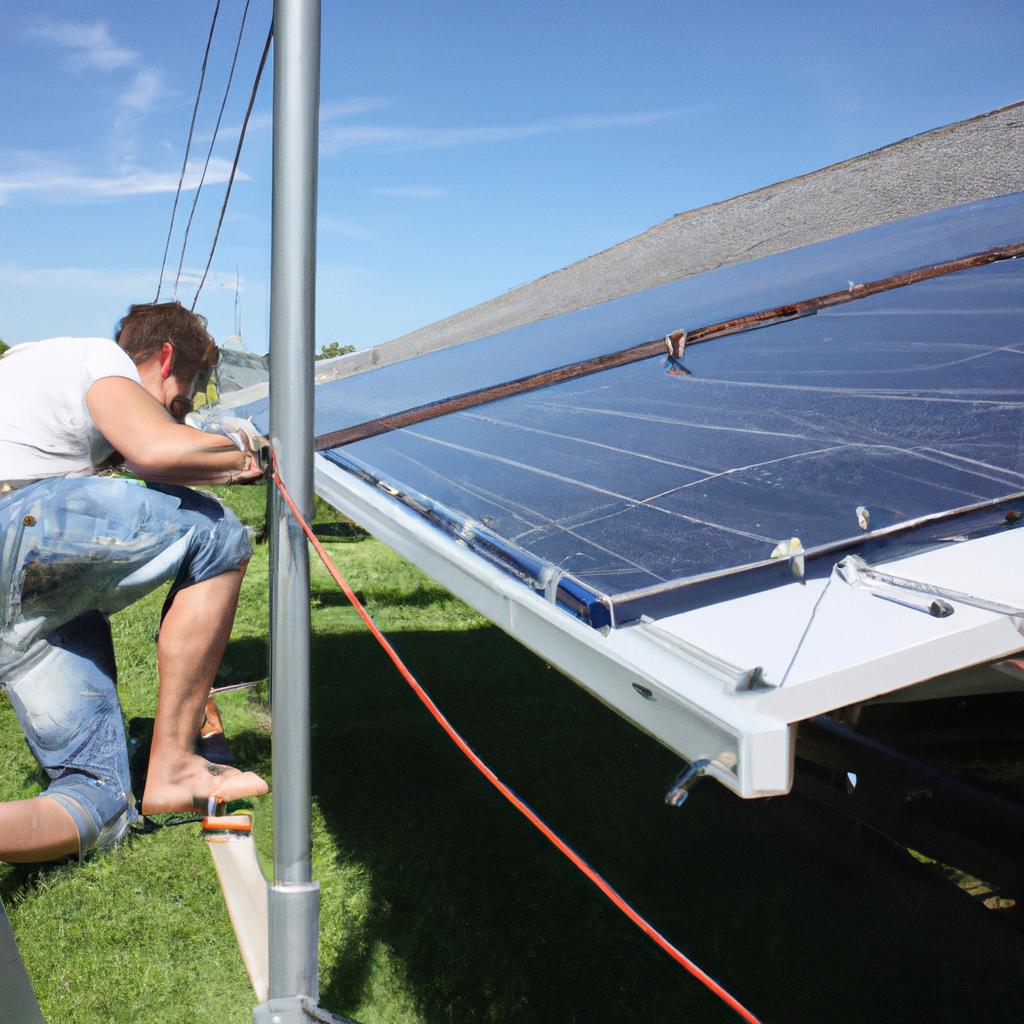The world is currently facing an unprecedented environmental crisis, with climate change and pollution posing significant threats to our planet’s sustainability. In response to these challenges, there has been a growing interest in renewable energy sources as a path towards achieving a more sustainable future. For instance, imagine a city powered entirely by wind turbines, where clean and abundant energy is harnessed from the natural forces of the wind. This hypothetical scenario exemplifies the potential for renewable energy revolutionizing our current energy systems while addressing pressing environmental concerns.
Renewable energy refers to energy derived from naturally replenishing sources such as sunlight, wind, water, and geothermal heat. Unlike fossil fuels that contribute to greenhouse gas emissions and environmental degradation, renewable energy offers a promising alternative solution that can mitigate these adverse effects. As researchers delve deeper into understanding the impacts of human activities on climate change and ecosystems, it becomes increasingly evident that transitioning to renewables is not only imperative but also urgent. Through innovative technologies and strategic deployment strategies, renewable energy represents an essential aspect of tackling environmental challenges head-on and forging a sustainable future for generations to come. However, despite its numerous benefits, there are still lingering questions regarding the feasibility and scalability of renewable solutions – particularly in terms of their economic viability, technological advancements required, and the necessary infrastructure upgrades.
One of the main concerns regarding renewable energy is its cost-effectiveness compared to traditional fossil fuels. While the initial investment for renewable energy infrastructure can be high, advancements in technology and economies of scale have significantly reduced costs over time. This trend is expected to continue as research and development efforts focus on improving efficiency and reducing manufacturing costs. Additionally, governments and organizations around the world are implementing policies and incentives to support the adoption of renewable energy, further driving down costs and making it more economically viable.
Another challenge lies in developing the necessary technologies to harness and store renewable energy efficiently. For example, wind turbines need to be designed to withstand various weather conditions while maximizing power generation. Likewise, solar panels must become more efficient at converting sunlight into electricity. Research and development efforts are ongoing to address these technological challenges and drive innovation in the renewable energy sector.
Furthermore, transitioning to a predominantly renewable energy system requires significant infrastructure upgrades. This includes building new transmission lines, upgrading existing grids, and establishing storage systems capable of storing excess energy for times when demand exceeds supply. Coordinated planning among governments, utility companies, and other stakeholders is crucial for ensuring a smooth transition without compromising reliability or affordability.
Despite these challenges, there has been substantial progress in adopting renewable energy worldwide. Many countries have set ambitious goals for increasing their share of renewables in their overall energy mix. Technological advancements continue to make renewables more accessible and affordable, while public awareness about the importance of sustainability drives demand for cleaner sources of power.
In conclusion, while there are still questions surrounding the feasibility and scalability of renewable solutions, there is no denying that they offer a promising path towards a sustainable future. With continued research, investments in technology development, supportive policies, and collaborative efforts across sectors, we can overcome these challenges and achieve a world powered by clean and abundant renewable energy sources – mitigating climate change risks while preserving our planet for future generations.
The Need for Renewable Energy
Renewable Energy Revolution: Addressing Environmental Concerns with Sustainable Solutions
The Need for Renewable Energy
The increasing demand for energy, coupled with the growing concerns over environmental degradation caused by conventional sources of power generation, has created an urgent need to transition towards renewable energy. To illustrate this point, let us consider the case of a small coastal town heavily reliant on fossil fuels for its electricity needs. Over time, the inhabitants noticed a decline in air quality and experienced respiratory issues due to high levels of pollution emitted from nearby power plants. This scenario highlights the detrimental impact that non-renewable energy sources can have on both human health and the environment.
To better understand why renewable energy is crucial in addressing these concerns, we must examine some key factors:
- Climate change mitigation: Transitioning to renewable energy sources reduces greenhouse gas emissions significantly, mitigating climate change effects such as rising global temperatures and extreme weather events.
- Improved air quality: Unlike traditional power plants that burn fossil fuels, renewable energy technologies produce minimal or no harmful emissions, resulting in cleaner air and improved human health.
- Resource sustainability: Renewable energy relies on abundant natural resources like sunlight, wind, water, and geothermal heat that are not depleted upon use. This ensures a sustainable supply of clean energy for future generations.
- Job creation and economic growth: Shifting towards renewable energy creates new employment opportunities across various sectors while promoting economic growth through investment in research, development, manufacturing, and installation of sustainable technologies.
| Advantages of Renewable Energy | Disadvantages of Conventional Sources | Benefits for Future Generations |
|---|---|---|
| – Reduced carbon footprint- Diversification of energy sources- Enhanced grid reliability | – Depletion of finite resources- Pollution and environmental damage- Volatile fuel prices | – A healthier planet free from harmful emissions- Access to sustainable energy for all- Economic prosperity |
Recognizing the pressing need for renewable energy solutions, governments, organizations, and individuals worldwide are now actively promoting the adoption of clean technologies. By transitioning to a more sustainable energy system, we can address environmental concerns while fostering economic growth and safeguarding our planet’s future.
In the subsequent section on “Current Environmental Challenges,” we will delve into some of the specific issues that highlight the urgent need for renewable energy as a viable solution.
Current Environmental Challenges
Renewable Energy Revolution: Addressing Environmental Concerns with Sustainable Solutions
While the need for renewable energy is evident, it is crucial to understand the current environmental challenges that necessitate urgent action. The consequences of climate change have become increasingly apparent, with rising global temperatures and extreme weather events occurring more frequently. To illustrate this point, let’s consider a hypothetical case study in which a coastal town experiences frequent flooding due to sea-level rise caused by melting ice caps. This scenario highlights the pressing need for sustainable solutions to mitigate these environmental concerns.
One way to comprehend the magnitude of our environmental challenges is through an emotional lens. Consider the following bullet points:
- Destruction of natural habitats leading to loss of biodiversity
- Air pollution causing respiratory diseases and other health issues
- Contamination of water sources impacting marine life and human consumption
- Greenhouse gas emissions exacerbating climate change effects
These distressing realities underscore the urgency of addressing environmental concerns through sustainable practices such as renewable energy adoption.
To further emphasize this urgency, we can examine a table showcasing some alarming statistics related to these challenges:
| Environmental Challenge | Statistics | Impact |
|---|---|---|
| Loss of Biodiversity | 1 million species | Disruption of ecosystems |
| Air Pollution | 4.2 million deaths | Health complications |
| Water Contamination | 780 million people | Impaired access |
| Climate Change | $54 trillion | Economic losses |
The figures presented above depict not only the scale of these challenges but also their profound impact on society and nature alike.
In light of these circumstances, it is imperative that we explore alternative solutions like renewable energy. By transitioning away from fossil fuels, we can significantly reduce greenhouse gas emissions while simultaneously mitigating various environmental risks associated with conventional power generation methods. Renewable energy sources, such as solar and wind power, offer sustainable alternatives that can help reverse the detrimental effects of climate change.
Transition into subsequent section:
Understanding the current environmental challenges lays the foundation for comprehending the benefits of renewable energy. By addressing these concerns head-on, we can pave a path towards a greener future that prioritizes sustainability without compromising on our energy needs.
Benefits of Renewable Energy
The current environmental challenges we face require urgent action in order to mitigate their detrimental effects. One notable example is the issue of air pollution resulting from fossil fuel combustion, which contributes to global warming and poses serious health risks. A hypothetical case study of a major city can help illustrate this point: imagine a bustling metropolis where smog-filled skies have become the norm, leading to increased respiratory illnesses among its inhabitants. This situation calls for sustainable solutions that address these concerns.
To combat the environmental challenges we face today, renewable energy presents itself as a viable solution. By harnessing natural resources such as sunlight, wind, water, and geothermal heat, we can generate clean and sustainable power without depleting finite fossil fuels or emitting harmful greenhouse gases. The benefits of renewable energy are numerous:
- Reduced carbon emissions: Unlike traditional energy sources like coal or oil, renewable energy technologies produce little to no carbon dioxide during operation.
- Improved air quality: With reduced reliance on fossil fuels, there will be a significant decrease in pollutants released into the atmosphere.
- Energy independence: Investing in renewables allows countries to diversify their energy portfolio and reduce dependence on imported fossil fuels.
- Job creation: The shift towards renewable energy creates new employment opportunities in sectors such as manufacturing, installation, and maintenance.
| Benefits of Renewable Energy |
|---|
| Reduced carbon emissions |
| Job creation |
These benefits not only contribute to mitigating climate change but also bring positive social and economic impacts. Transitioning to renewable energy sources represents an important step towards building a more sustainable future.
Transitioning into the subsequent section about “Types of Renewable Energy Sources,” it is essential to explore various options available for generating clean power. By understanding different types of renewable energy sources and their unique potentials, we can further advance our efforts in addressing environmental concerns and fostering a sustainable future.
Types of Renewable Energy Sources
Building upon the numerous benefits of renewable energy, it is crucial to delve into the various types of renewable energy sources available today. By exploring these diverse options and their unique advantages, we can gain a deeper understanding of how sustainable solutions can address environmental concerns.
-
Solar Power:
- Example: In 2015, the Kamuthi Solar Power Project in India became the world’s largest single-location solar park, generating enough electricity to power approximately 150,000 homes.
- Harnessing sunlight through photovoltaic panels or concentrated solar power systems.
- Provides clean energy without emitting greenhouse gases.
- Reduces dependence on fossil fuels for electricity generation.
-
Wind Energy:
-
Hydropower:
-
Geothermal Energy:
| Renewable Energy Source | Advantages |
|---|---|
| Solar Power | Clean and abundant |
| Wind Energy | Scalable and cost-effective |
| Hydropower | Reliable and versatile |
| Geothermal Energy | Constant and low emissions |
These renewable energy sources offer significant advantages over traditional fossil fuel-based methods of power generation. Emphasizing sustainability, they provide environmentally friendly alternatives while addressing our growing energy needs.
As technological advancements continue to shape the field of renewable energy, ongoing research and development efforts are focused on enhancing efficiency and increasing affordability. This progress in technology holds great promise for accelerating the adoption of sustainable solutions worldwide.
Technological Advancements in Renewable Energy
Building upon the understanding of various renewable energy sources, it is crucial to explore the technological advancements that have propelled the implementation and adoption of these sustainable alternatives. By examining the progress made in harnessing renewable energy, we can gain insights into the potential for a greener future.
One notable example of technological advancement in renewable energy is the development and utilization of solar photovoltaic (PV) systems. These systems convert sunlight directly into electricity through the use of solar cells, enabling individuals and businesses to generate their own clean power. For instance, consider a hypothetical case study where a residential building installs rooftop solar panels. This investment not only reduces dependence on fossil fuels but also enables homeowners to contribute excess energy back to the grid, fostering a more efficient and decentralized energy system.
To comprehend the impact of technological advancements in renewable energy, it is essential to recognize several key factors:
- Cost Reduction: Technological innovations have significantly reduced the cost associated with installing and maintaining renewable energy infrastructure.
- Efficiency Improvements: Advances in materials science and engineering techniques have improved the efficiency at which renewable technologies convert natural resources into usable forms of energy.
- Grid Integration: Sophisticated control systems now enable seamless integration between intermittent renewable sources like wind or solar power and traditional electrical grids.
- Storage Solutions: The advent of affordable and scalable battery storage solutions has addressed one of the primary challenges faced by renewables – intermittency.
Table: Comparative Analysis – Traditional vs. Advanced Renewable Technologies
| Aspect | Traditional Technologies | Advanced Technologies |
|---|---|---|
| Environmental Impact | High carbon emissions | Low or zero carbon emissions |
| Resource Dependence | Finite fossil fuel reserves | Abundant and inexhaustible resources |
| Scalability | Limited capacity expansion | Highly scalable installations |
| Economic Viability | Rising costs due to resource depletion | Cost-effectiveness and long-term savings |
These advancements in renewable energy technologies present immense potential for addressing environmental concerns and fostering a sustainable future. Embracing these technological breakthroughs can lead to reduced greenhouse gas emissions, decreased reliance on finite resources, and enhanced energy security.
As we delve deeper into the realm of sustainable solutions for a greener future, it is crucial to explore not only technological innovations but also policy frameworks that incentivize their adoption.
Sustainable Solutions for a Greener Future
Renewable Energy Revolution: Addressing Environmental Concerns with Sustainable Solutions
Technological advancements in renewable energy have paved the way for a greener and more sustainable future. As we transition away from fossil fuels, innovative solutions are emerging to address environmental concerns and mitigate the negative impacts of traditional energy sources. One such example is the successful implementation of solar power systems in remote communities.
Imagine a small village nestled deep within a rugged mountain range, far away from any major cities or infrastructure. This community relied solely on diesel generators for their electricity needs, resulting in high costs, air pollution, and noise disturbances. However, through the installation of solar panels coupled with battery storage technology, this village has achieved energy independence while significantly reducing their carbon footprint.
This case study exemplifies how technological advancements in renewable energy can bring about positive change even in challenging environments. But it doesn’t stop there; sustainable solutions offer numerous benefits that resonate with both individuals and society as a whole:
- Environmental Preservation: Renewable energy sources like wind, solar, hydroelectric power, and geothermal energy generate electricity without depleting natural resources or emitting harmful greenhouse gases.
- Economic Growth: Investing in renewable energy creates job opportunities across various sectors such as manufacturing, installation, maintenance, and research & development.
- Energy Security: By diversifying our energy mix and relying less on imported fossil fuels susceptible to price fluctuations and geopolitical tensions, we can enhance our national security.
- Public Health Improvement: Shifting to clean energy helps reduce air pollution levels associated with respiratory diseases and improves overall public health outcomes.
Table 1 showcases the environmental benefits of adopting sustainable practices compared to conventional methods:
| Conventional Methods | Sustainable Practices | |
|---|---|---|
| Energy Source | Fossil Fuels (Coal/Oil/Gas) | Renewable Sources (Wind/Solar/Hydro/Geothermal) |
| Greenhouse Gas Emissions | High | Low |
| Air Pollution | Significant | Minimal to None |
| Resource Depletion | Depletes Finite Resources | Uses Infinite Resources |
In conclusion, the renewable energy revolution is not just a futuristic concept—it is already happening. Technological advancements have enabled us to harness clean and sustainable sources of energy, addressing environmental concerns while providing economic opportunities and improving public health. By embracing these solutions, we can create a greener future for generations to come, leaving behind a legacy of responsible stewardship and innovation in the face of global challenges.





